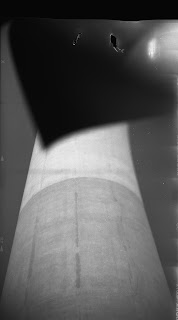The first photos from the Brownie have been developed.
First off, it worked. That’s the big take-away and the part that makes me really happy. Beyond that, I learned some valuable lessons about HOW the camera works and what I might do going forward to get the best images out of the old girl. (Side note: I feel like this camera needs a name.) But, again, the exciting thing is that this 100 year old camera can capture some terrific images despite all the limitations and challenges.
The processor was bale to get two photos off the first roll and four (well, three and a half) off of the second. Much of the learning process is going to be figuring out how to load and wind the film to get the most use of the roll. This camera shoots in a very panoramic format. The negatives are 6mm high (the width of the film) and 11mm wide. I think, after a little quick measuring of the negatives I got back, ideally there are a possible six images on each roll. I need to find a way to nail down how to get the very first frame lined up. That will be the tough part. Then it’s just a matter if how many turned move the film along properly between images. Having exposed negatives to work with will be a help there.
Beyond that, I can go though each image and see what went right and what went wrong and take some lessons there.
This is the very first one, and not terrible given that fact. I was under the Oak Island pier on a sunny day, which I know can look very cool. Tis I that have been a bit tricky of a situation for this camera, though, with deep shadows and bright highlights. I used a phone app light meter and went with the f22 at 1/100th that it recommended. That was not enough exposure. I should have opened it up to f16 and I might have gotten some detail in the pier. I at first thought that the light at the upper left was bright sun coming in, but looking at the rest of the photos, I see that I have a light leak of some sort. Not sure if I should try to fix it or accept it as adding character to the photos from this camera. I am really pleased with the detail in the sand in the foreground though. Very hopeful of what this camera could be capable of.
This is an accidental double exposure caused by my forgetting to wind the film between two shots, both of boats. The light leak is evident again, but doesn’t ruin the shot. I’m happy with the exposure here and think the first image, the boat facing away from us in the photo, would have been a pretty spectacular photo if I had wound the film. But the more I look at the double exposure, the more I kind of like it.
I didn’t wind the film enough on this roll at the beginning because this is the first image of the second roll but the second I took. This is the wall at Veterans Park near our house. I used the mid-range focus here and meter reading from the app. Everything worked pretty well here. The exposure is good, the focus is good, even if it does fall off a bit on the edges. I think that is a function of how the film sits since it’s not quite wide enough to sit on the frame inside the camera the way 116 film would. But the focus on the center emblem sis spot-on, which is amazing for a 100 year old lease focused by guessing distance. The contrast is cool, too. One thing that is really tricky is getting a straight horizon using the viewfinder on this camera. We’ll chalk that up to “character” too.
I think the winder wasn’t catching the take up reel properly on this roll. I didn’t forget to wind between shots, but still ended up with this double exposure. Again, I think the portrait of Lisa here would have been really good. Makes me want to try that again and see what happens.
This is far bad away the best of the lot. This is the image that makes me want to keep at it because it is absolutely cool. I used the “infinity” focus and it did a great job of keeping the lighthouse sharp. The exposure is spot on again and the detail in the shadows is great. It’s not even too off-kilter, really. I got the rail as a leading line. The super pano aspect ratio lends itself splendidly to lighthouses! I rested the camera on the rail to minimize shake, which worked well. Looking for a spot to do that might be key to getting the sharpest images as such a slow shutter speed.
Here’s the end of the roll.
So there we are. I’ve since shot another roll and it’s still in the camera waiting for my developer kit to arrive. I loved The Darkroom, the processor who developed and scanned these for me, but it simply is too big an investment in money and time given what I think will be the relative ease of home developing.
That will be another adventure, though.










Love seeing these
ReplyDelete